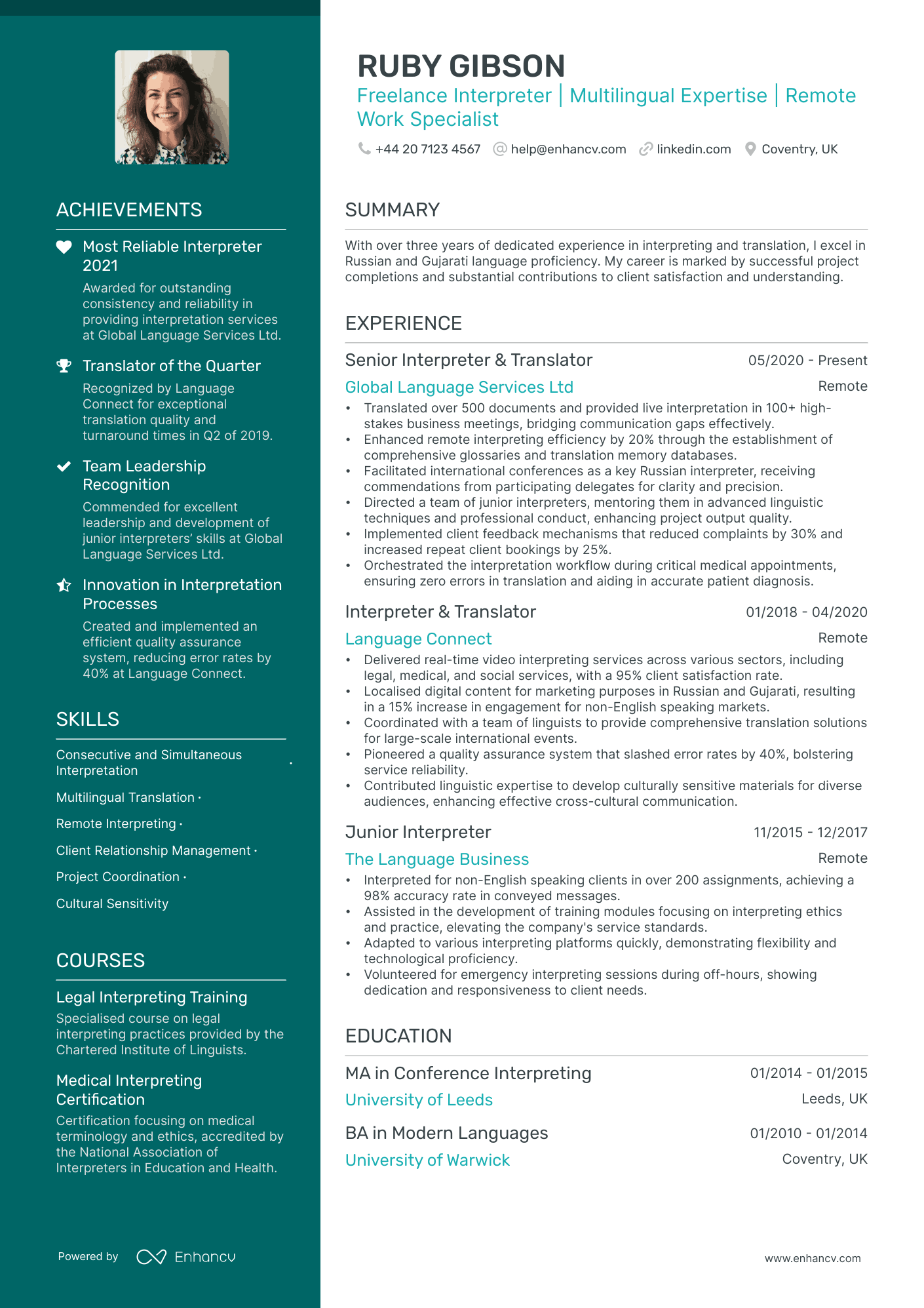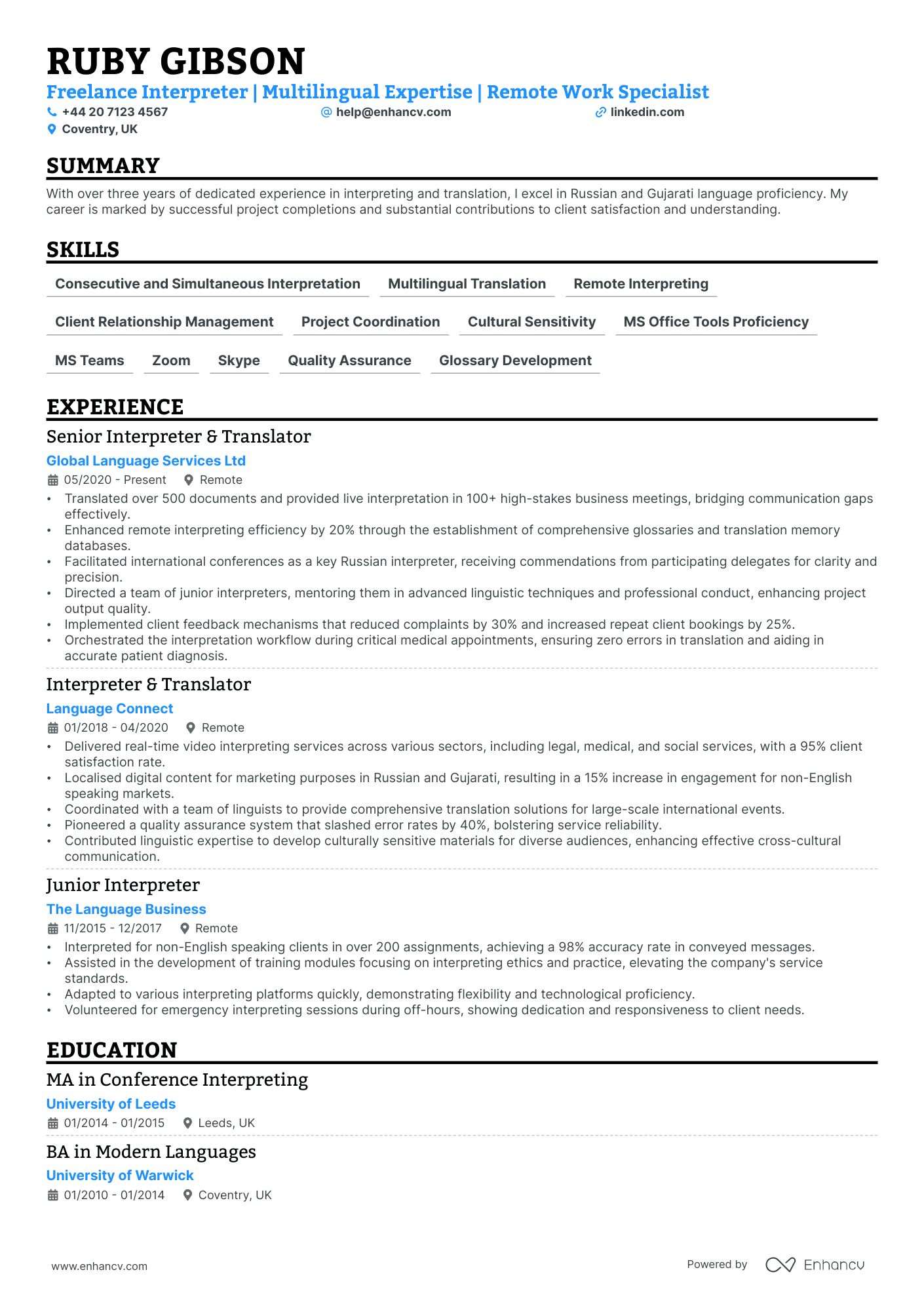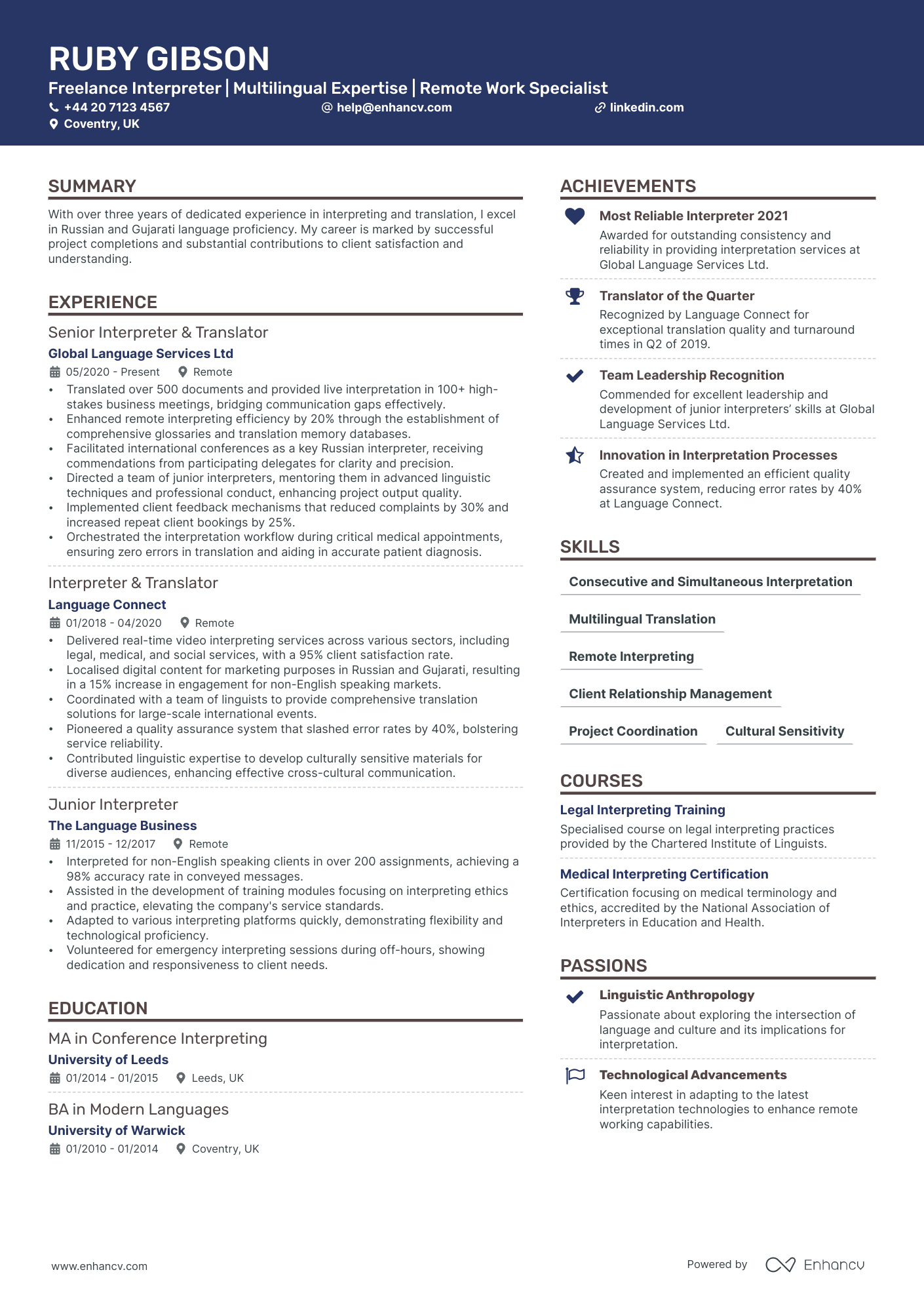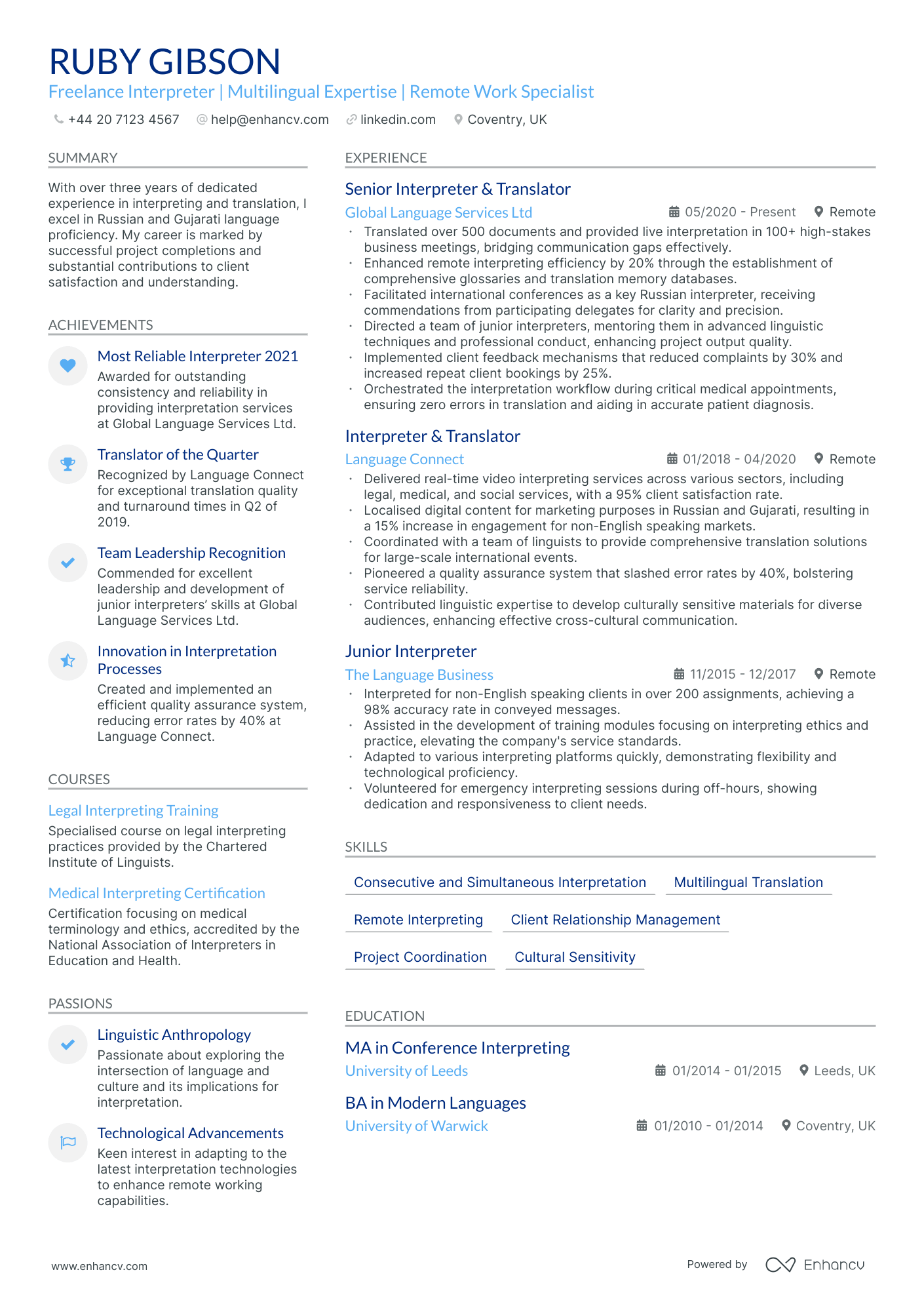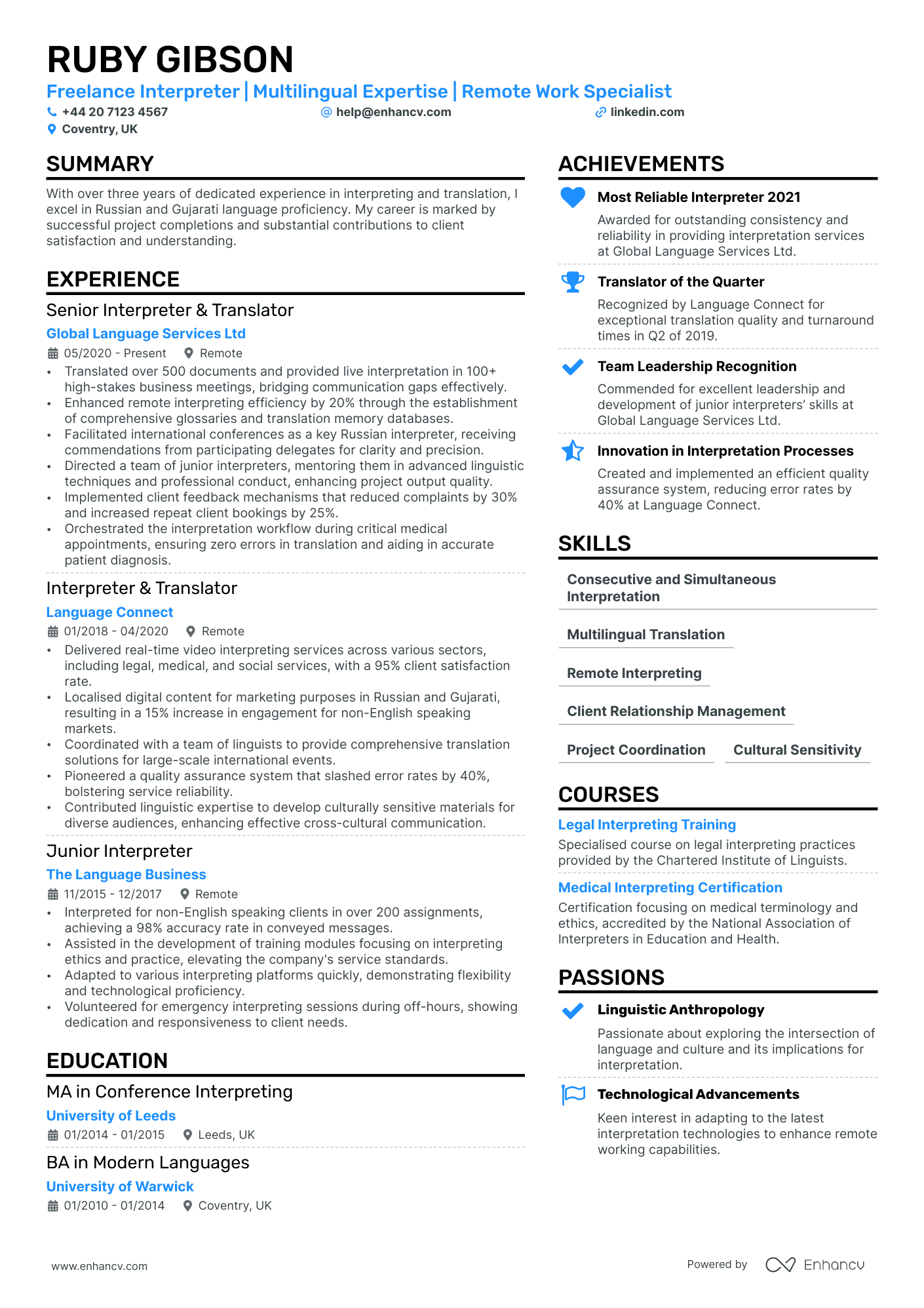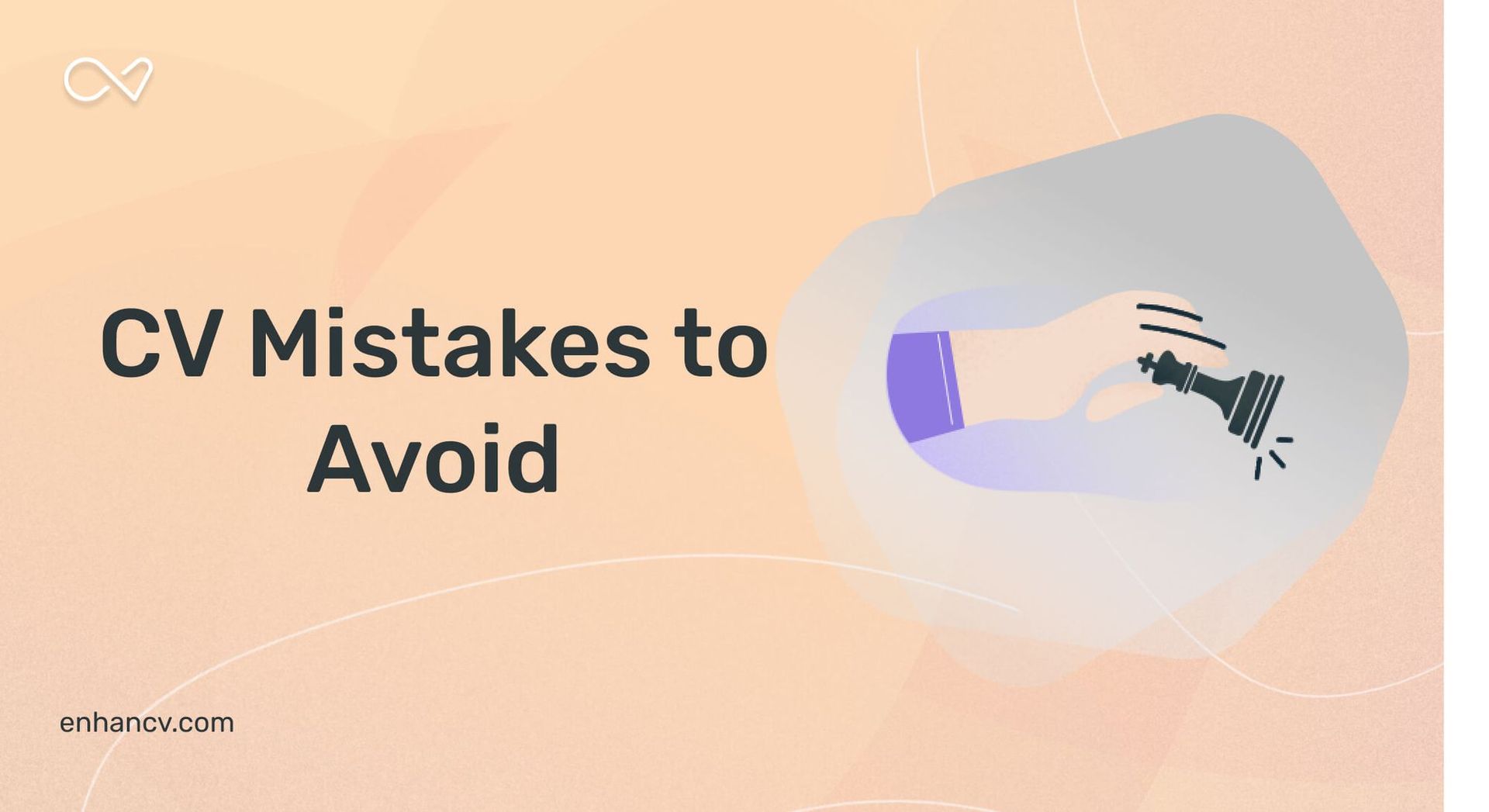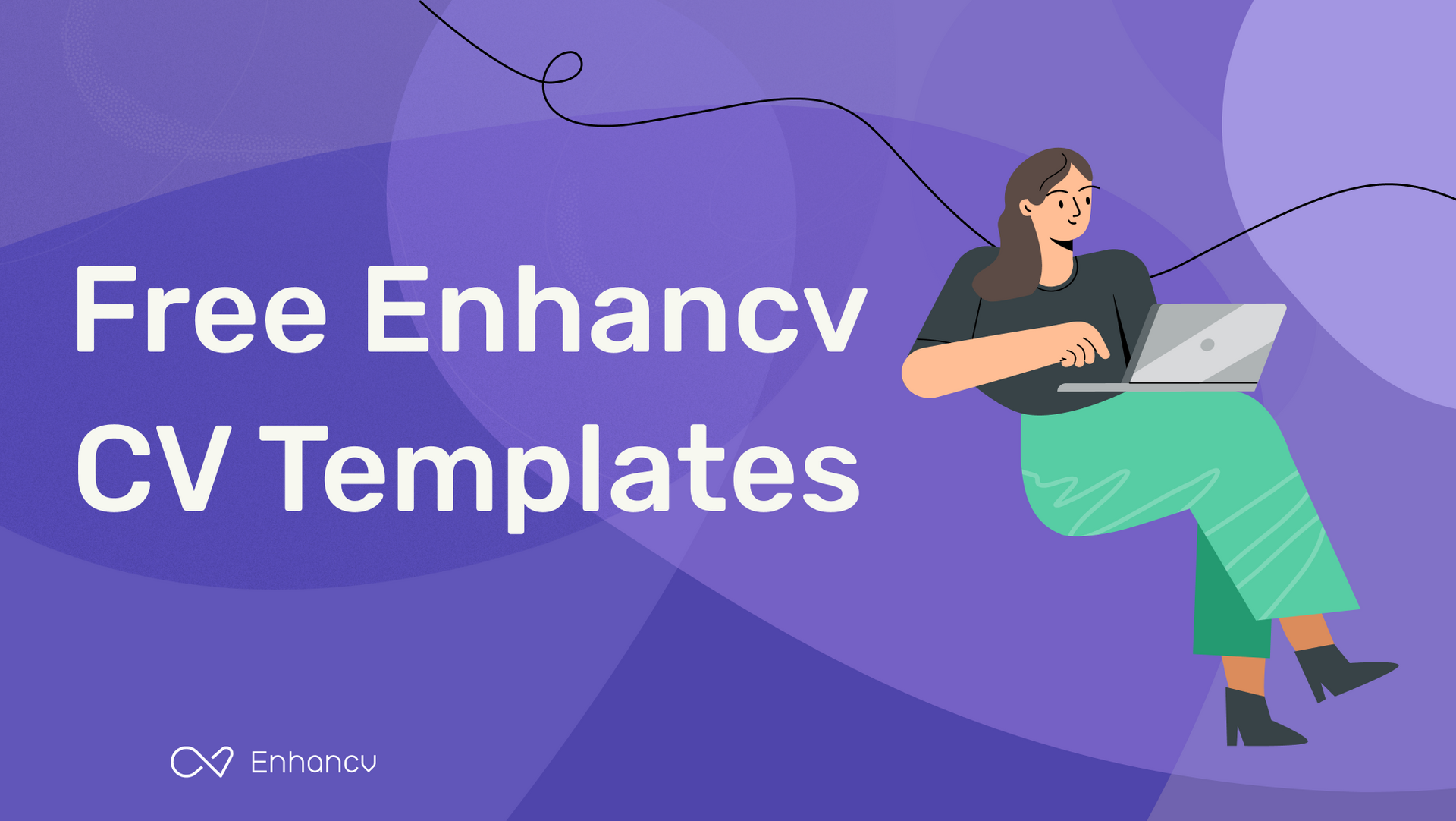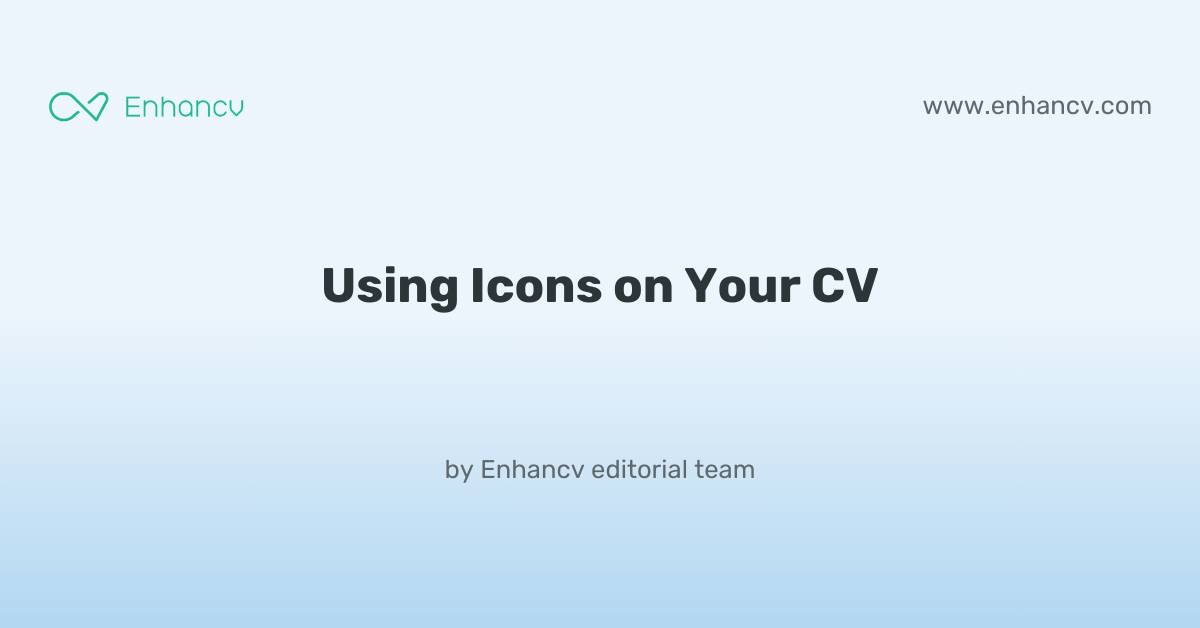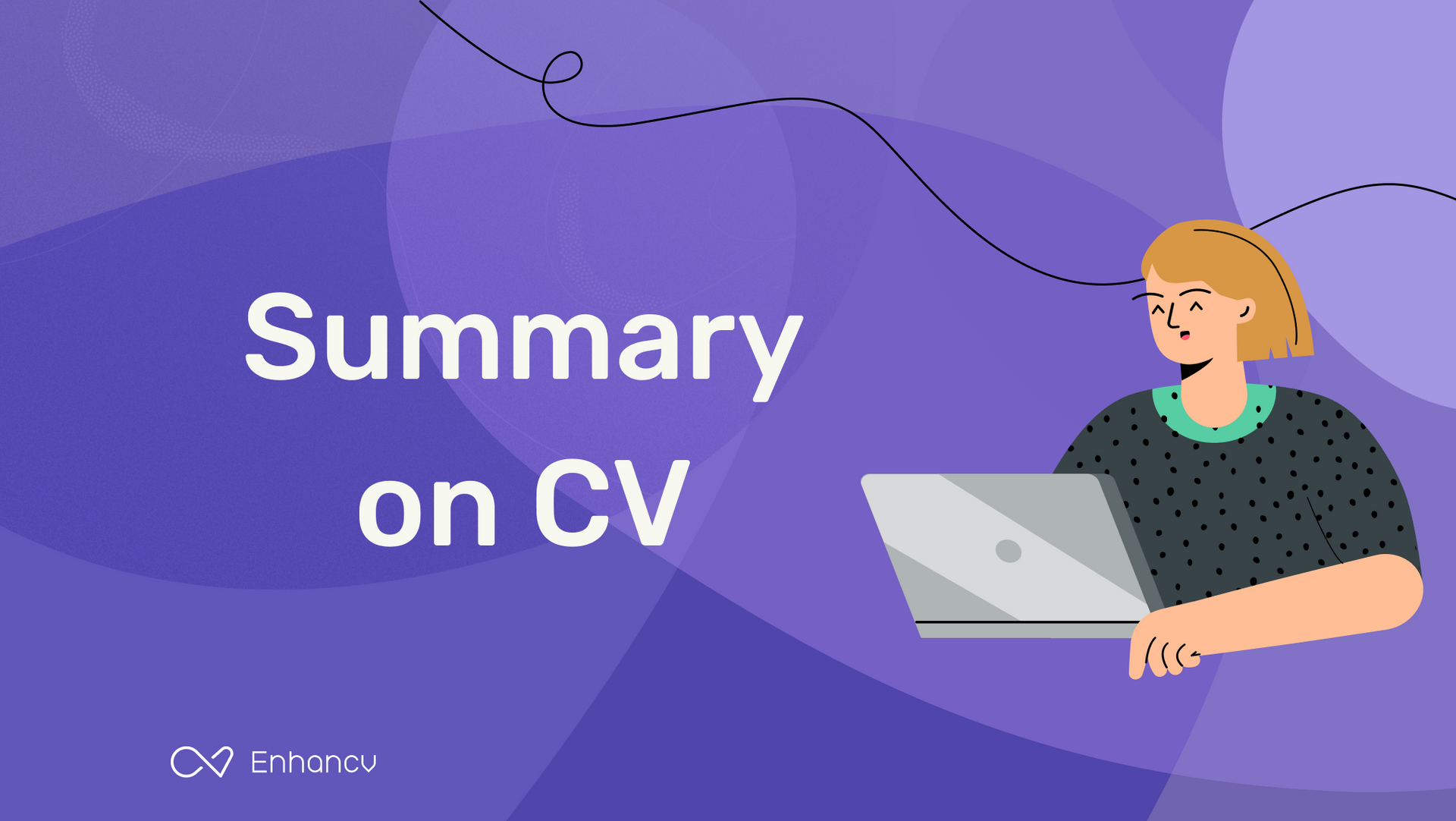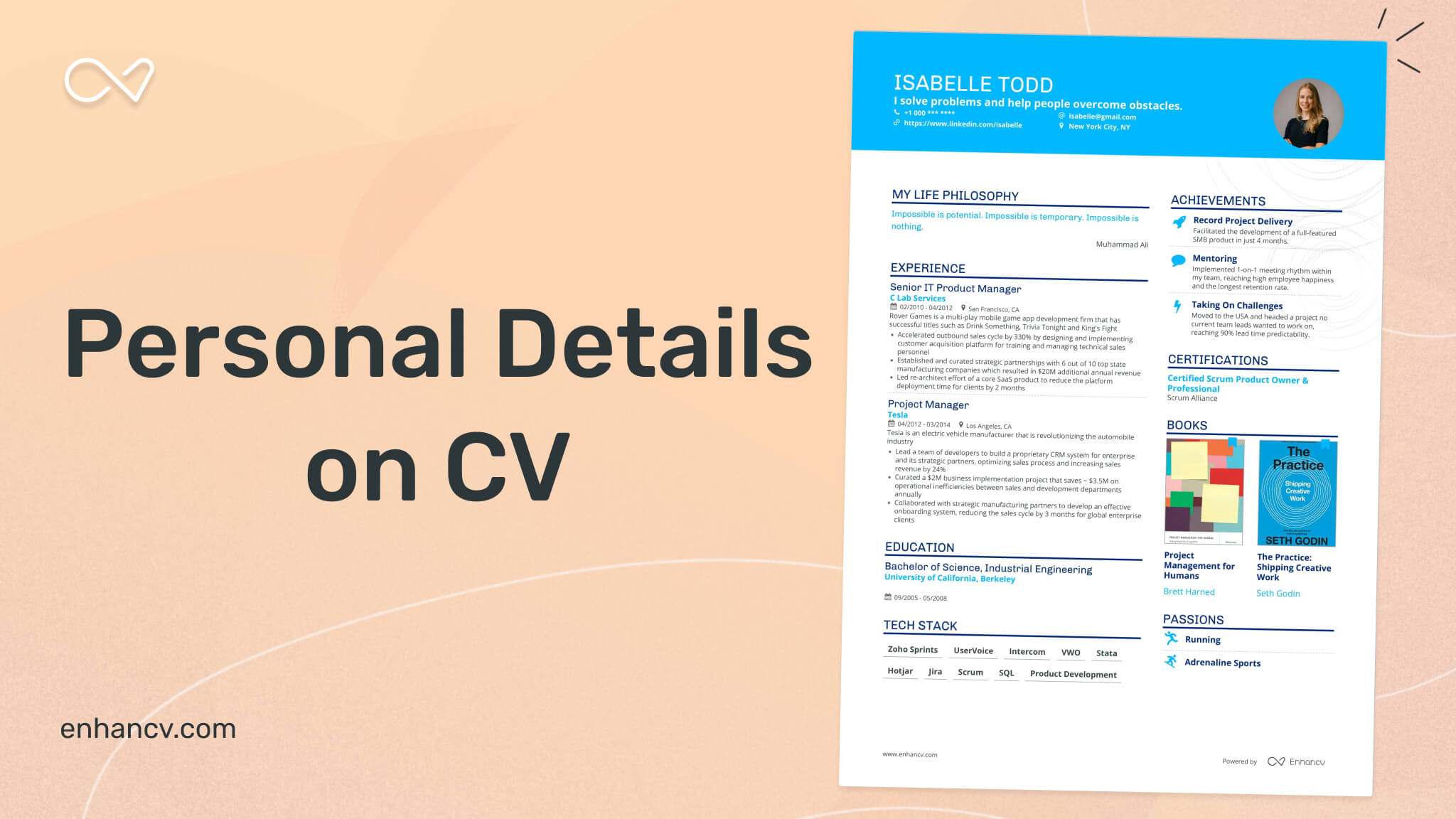One specific CV challenge you might face as a translator is ensuring your unique language skills and cultural competencies stand out to potential employers. Our guide provides tailored strategies to highlight these abilities effectively, ensuring your CV not only showcases your expertise but also captures the attention of those looking for your specialised translation services.
- Answer job requirements with your translator CV and experience;
- Curate your academic background and certificates, following industry-leading CV examples;
- Select from +10 niche skills to match the ideal candidate profile
- Write a more succinct experience section that consists of all the right details.
Do you need more specific insights into writing your translator CV? Our guides focus on unique insights for each individual role:
How complex should the format of your translator CV be?
Perhaps, you decided to use a fancy font and plenty of colours to ensure your translator CV stands out amongst the pile of other candidate profiles. Alas - this may confuse recruiters. By keeping your format simple and organising your information coherently, you'll ultimately make a better impression. What matters most is your experience, while your CV format should act as complementary thing by:- Presenting the information in a reverse chronological order with the most recent of your jobs first. This is done so that your career history stays organised and is aligned to the role;
- Making it easy for recruiters to get in touch with you by including your contact details in the CV header. Regarding the design of your CV header, include plenty of white space and icons to draw attention to your information. If you're applying for roles in the UK, don't include a photo, as this is considered a bad practice;
- Organising your most important CV sections with consistent colours, plenty of white space, and appropriate margins (2.54 cm). Remember that your CV design should always aim at legibility and to spotlight your key information;
- Writing no more than two pages of your relevant experience. For candidates who are just starting out in the field, we recommend to have an one-page CV.
One more thing about your CV format - you may be worried if your double column CV is Applicant Tracker System (ATS) complaint. In our recent study, we discovered that both single and double-column CVs are ATS-friendly . Most ATSes out there can also read all serif and sans serif fonts. We suggest you go with modern, yet simple, fonts (e.g. Rubik, Lato, Raleway) instead of the classic Times New Roman. You'll want your application to stand out, and many candidates still go for the classics. Finally, you'll have to export your CV. If you're wondering if you should select Doc or PDF, we always advise going with PDF. Your CV in PDF will stay intact and opens easily on every OS, including Mac OS.
PRO TIP
Use bold or italics sparingly to draw attention to key points, such as job titles, company names, or significant achievements. Overusing these formatting options can dilute their impact.
The top sections on a translator CV
- Language Proficiency because accurate translations depend on linguistic expertise.
- Translation Specialisations showing areas of expertise ensures a good fit for specific projects.
- Translation Work Experience to demonstrate practical application of translation skills.
- Education and Training in Translation to highlight formal qualifications and specialised knowledge.
- CAT Tools Proficiency as familiarity with computer-aided translation tools is often essential.
What recruiters value on your CV:
- Highlight your language proficiency by detailing your fluency levels in all languages you can translate, including certifications or language assessment scores that can corroborate your expertise.
- Emphasise your specialist subject areas, whether that be medical, legal, technical, or literary translation, to showcase your niche strengths and previous experience.
- Include your experience with translation tools and software, such as CAT (Computer-Assisted Translation) tools, to demonstrate your efficiency and familiarity with current industry standards.
- Provide specifics about the volumes of work you are capable of handling, such as word counts per day or turnaround times, to give potential employers an idea of your productivity levels.
- Mention any notable projects or clients you’ve worked with, as this can highlight your reliability and the quality of your work in real-world translation scenarios.
Recommended reads:
Our checklist for the must-have information in your translator CV header
Right at the very top of your translator CV is where you'd find the header section or the space for your contact details, headline, and professional photo. Wondering how to present your the name of the city you live in and the country abbreviation as your address;
- are tailored to the role you're applying for by integrating key job skills and requirements;
- showcase what your unique value is, most often in the form of your most noteworthy accomplishment;
- select your relevant qualifications, skills, or current role to pass the Applicant Tracker System (ATS) assessment. Still not sure how to write your CV headline? Our examples below showcase best practices on creating effective headlines:
Examples of good CV headlines for translator:
- Senior Translator and Linguistic Consultant | MA Translation Studies | Legal and Financial Specialism | 10+ Years Experience
- Expert Technical Translator | BSc Engineering | Patents, User Manuals | Chartered Linguist | 8 Years in Field
- Multilingual Communication Specialist | Certified in Localization | Marketing and Media Content | 5 Years Professional Practice
- Professional Literary Translator | PhD Comparative Literature | Fiction, Poetry | ATA Certified | 12 Years Expertise
- Medical and Pharmaceutical Translator | MSc Biomedical Science | Clinical Trials, Regulatory Documents | 7 Years Experience
- Junior Conference Interpreter | BA Languages & Interpreting | Simultaneous and Consecutive | EU Accredited | 3 Years Active
Opting between a translator CV summary or objective
Within the top one third of your translator CV, you have the opportunity to briefly summarise your best achievements or present your professional goals and dreams. Those two functions are met by either the CV summary or the objective.
- The summary is three-to-five sentences long and should narrate your best successes, while answering key requirements for the role. Select up to three skills which you can feature in your summary. Always aim to present what the actual outcomes were of using your particular skill set. The summary is an excellent choice for more experienced professionals.
- The objective is more focused on showcasing your unique value as a candidate and defining your dreams and ambitions. Think about highlighting how this current opportunity would answer your career vision. Also, about how you could help your potential employers grow. The objective matches the needs of less experienced candidates, who need to prove their skill set and, in particular, their soft skills.
Still not sure about how to write your CV opening statement? Use some best industry examples as inspiration:
CV summaries for a translator job:
- With over 7 years of dedicated experience in translation and localisation services, fluent in 4 languages including Japanese and Spanish, I have successfully translated over 5000 pages of technical documentation, propelling productivity for global tech companies and receiving the 'Outstanding Translator' award in 2021.
- Distinguished bilingual professional with a decade-long career in diplomatic services, now aiming to leverage expertise in English and French translation. Renowned for brokering international agreements through precise linguistic skills, my career highlight includes interpreting at the United Nations Climate Summit.
- Adept software developer with a passion for linguistics, I bring 5 years of coding experience with a focus on automation tools. Keen to apply my technical skills to the translation industry, I am well-versed in both Python and Russian language, eager to contribute to high-stakes translation projects.
- Former journalist with a flair for storytelling, shifting into translation after 6 years of crafting compelling narratives in English and Arabic. My dedication to factual accuracy and cultural nuance will be instrumental in providing top-notch translation services.
- As an eager graduate with a First-Class Honours degree in Modern Languages, I am intent on forging a career where my advanced proficiency in Mandarin and German, along with an innate aptitude for linguistic nuances, can make a substantial impact on cross-cultural communication.
- Driven individual seeking to embark on a career in translation. Bringing forth a zealous dedication to learning and a recent certification in Legal Translation, I am fully prepared to deliver meticulous attention to detail and accuracy in multiple language pairs.
The best formula for your translator CV experience section
The CV experience section is the space where many candidates go wrong by merely listing their work history and duties. Don't do that. Instead, use the job description to better understand what matters most for the role and integrate these keywords across your CV. Thus, you should focus on:
- showcasing your accomplishments to hint that you're results-oriented;
- highlighting your skill set by integrating job keywords, technologies, and transferrable skills in your experience bullets;
- listing your roles in reverse chronological order, starting with the latest and most senior, to hint at how you have grown your career;
- featuring metrics, in the form of percentage, numbers, etc. to make your success more tangible.
When writing each experience bullet, start with a strong, actionable verb, then follow it up with a skill, accomplishment, or metric. Use these professional examples to perfect your CV experience section:
Best practices for your CV's work experience section
- Detail your language pairs and levels of proficiency, stating any language certifications or assessments you have passed to validate your linguistic capabilities.
- Emphasise your specialisation areas, such as legal, medical, or technical translation, illustrating your expertise with examples of projects or documents you have worked on.
- Highlight any CAT (Computer-Assisted Translation) tools you are proficient in, such as SDL Trados or MemoQ, as these are often essential for efficient translation work.
- Include experience with localisation and the ability to adapt content culturally, which is crucial for translating websites, video games, or marketing materials.
- Document your ability to maintain the style, tone, and voice of the original content, thus ensuring a high-quality translation that reads naturally.
- Showcase your attention to detail by mentioning any proofreading or editing experience, which demonstrates your commitment to delivering error-free translations.
- Provide metrics when possible, such as the number of words translated per day or the volume of projects completed, to give potential employers an idea of your capacity.
- Mention any relevant experience in subtitling, dubbing, or voice-over work if applicable, as these skills are increasingly in demand for multimedia content.
- Note any professional memberships, such as the Institute of Translation and Interpreting (ITI) or the Chartered Institute of Linguists (CIOL), to establish your professional credibility.
- Translated over 3,000 pages of legal documents with a focus on accuracy, resulting in a 99.5% client satisfaction rate for Global Law Associates.
- Initiated and managed a terminology database for legal jargon, which reduced translation inconsistencies by 40% across the firm's international offices.
- Collaborated with a team of 5 translators to create a training module for new hires on cultural nuances in legal translation, slashing onboarding time by 25%.
- Led a team of 10 translators in a project translating a series of medical research papers, enhancing global accessibility and contributing to 10% more citations for MedTranslate Co.
- Implemented an AI-assisted translation workflow which increased output by 35%, ensuring timely delivery of critical medical information.
- Spearheaded a cross-functional collaboration between translators and medical professionals to improve translation accuracy of technical terms at Health International.
- Expertly adapted over 50 hours of video content for subtitling in foreign markets, expanding viewership for Multimedia Entertainment by 200% in non-English speaking countries.
- Pioneered an interpreter training program to support live events, which was later adopted by other departments due to its effectiveness in reducing misunderstandings.
- Collaborated with scriptwriters to maintain narrative integrity during the translation of a high-profile TV series, resulting in critical acclaim and international sales.
- Expert translation of complex technical manuals for industrial machinery enabled Bridgetech Industries to expand sales to French and German-speaking markets by 20%.
- Served as primary liaison between engineering teams and international clients, facilitating effective communication that led to an increase in repeat business.
- Orchestrated the implementation of CAT tools which improved translation speed and consistency across all technical documentation.
- Translated and localized website content for PlayMax Games, resulting in a 35% boost in traffic from Spanish-speaking markets.
- Developed glossaries for gaming terminology that standardised translations across multiple projects and thus ensured a coherent brand voice.
- Facilitated communication between developers and international marketing teams, playing a pivotal role in product launches in three new countries.
- Accurately translated over 1,000 pages of financial documents for annual reports, enabling International Finance Corp to comply with multi-national regulatory requirements.
- Identified and resolved translation discrepancies in quarterly earnings reports, thereby preserving the company's reputation among Francophone investors.
- Translated live, high-stakes negotiations during twelve international banking summits, ensuring seamless communication and contributing to successful deal closures.
- Crafted and implemented translation strategies for e-commerce platforms, which helped GlobalMart reach a 50% sales increase in non-English speaking territories.
- Led a localization project for the GlobalMart App, which led to becoming the most downloaded shopping app in three distinct language regions.
- Managed a team of freelance translators and proofreaders, ensuring alignment with brand voice and a 30% improvement in content delivery times.
- Provided simultaneous interpreting for 200+ conferences, enhancing dialogue between English and Mandarin speakers within the Tech Innovate Conference series.
- Designed a cultural sensitivity training program for interpreters, which led to a 15% increase in positive feedback from international delegates.
- Compiled and maintained a technical glossary for the tech sector, which became the reference standard for subsequent translations within the organization.
Lacking professional expertise: how to write your CV to highlight your best talents
Don't count on your lucky stars when you're applying for a role, where you happen to have less (or almost none) professional experience. Recruiters sometimes do hire inexperienced candidates if they're able to present their unique value from the get-go. So, instead of opting for the traditional, CV experience section:
- List any applicable expertise you happen to have - no matter if it's a part-time job, internship, or volunteer work. This would hint to recruiters that your profile is relevant;
- Focus your CV on your transferrable skills or talents you've obtained thanks to your whole life and work experience. In effect, you'll be spotlighting your value as a candidate;
- Separate more space for your applicable academic background and certificates to show you have the technical know-how;
- Ensure that within your objective, you've defined why you'll like the job and how you'll be the perfect match for it. Always ensure you've tailored your CV to individual applications.
Looking for more good examples for your first job? We'll show you how other candidates, with less professional experience, have created their job-winning CVs.
Recommended reads:
PRO TIP
If you have experience in diverse fields, highlight how this has broadened your perspective and skill set, making you a more versatile candidate.
Key translator CV skills: what are hard skills and soft skills
Let's kick off with the basics. You know that you have to include key job requirements or skills across your CV. For starters, take individual skills from the job description and copy-paste them into your CV, when relevant. Doing so, you'll ensure you have the correct skill spelling and also pass the Applicant Tracker System (ATS) assessment. There are two types of skills you'll need to include on your CV:
- Hard skills - technical abilities that are best defined by your certificates, education, and experience. You could also use the dedicated skills section to list between ten and twelve technologies you're apt at using that match the job requirements.
- Soft skills - your personal traits and interpersonal communication skills that are a bit harder to quantify. Use various CV sections, e.g. summary, strengths, experience, to shine a spotlight on your workspace achievements, thanks to using particular soft skills.
Remember that your job-winning CV should balance both your hard and soft skills to prove your technical background, while spotlighting your personality.
Top skills for your translator CV:
Fluency in Source Language
Fluency in Target Language
Translation Techniques
Cultural Knowledge
Proofreading
Localisation
Terminology Research
Computer-Assisted Translation (CAT) Tools
Language Pair Specialisation
Text Type Specialisation
Attention to Detail
Interpersonal Communication
Time Management
Adaptability
Problem Solving
Critical Thinking
Resourcefulness
Continuous Learning
Professionalism
Teamwork
PRO TIP
Focus on describing skills in the context of the outcomes they’ve helped you achieve, linking them directly to tangible results or successes in your career.
Your university degree and certificates: an integral part of your translator CV
Let's take you back to your uni days and decide what information will be relevant for your translator CV. Once more, when discussing your higher education, select only information that is pertinent to the job (e.g. degrees and projects in the same industry, etc.). Ultimately, you should:
- List only your higher education degrees, alongside start and graduation dates, and the university name;
- Include that you obtained a first degree for diplomas that are relevant to the role, and you believe will impress recruiters;
- Showcase relevant coursework, projects, or publications, if you happen to have less experience or will need to fill in gaps in your professional history.
PRO TIP
Use mini case studies or success stories in your CV to demonstrate how your skills have positively impacted previous roles or projects.
Recommended reads:
Key takeaways
What matters most in your translator CV-writing process is for you to create a personalised application. One that matches the role and also showcases your unique qualities and talents.
- Use the format to supplement the actual content, to stand out, and to ensure your CV experience is easy to comprehend and follows a logic;
- Invest time in building a succinct CV top one third. One that includes a header (with your contact details and headline), a summary or an objective statement (select the one that best fits your experience), and - potentially - a dedicated skills section or achievements (to fit both hard skills and soft skills requirements);
- Prioritise your most relevant (and senior) experience closer to the top of your CV. Always ensure you're following the "power verb, skill, and achievement" format for your bullets;
- Integrate both your technical and communication background across different sections of your CV to meet the job requirements;
- List your relevant education and certificates to fill in gaps in your CV history and prove to recrutiers you have relevant technical know-how.
